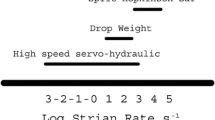Abstract
A new impact-tension-compression testing technique based on a one-dimensional elastic-stress-wave theory has been developed. The technique was applied to investigate dynamic response in pure iron. The experimental results of the loading wave agreed well with the theoretical prediction. The stress, strain, and strain rate of a specimen during impact were evaluated with the aid of a stress-wave analysis. A new experimental technique has been developed to investigate the dynamic-hysteresis loop and the dynamic Baushinger effect in materials. It is presently being developed for applications to dynamic-fatigue studies.
Similar content being viewed by others
References
Hauser, P.E., Simmons, J.A. andDorn, J.E., “Strain Rate Effects in Plastic Wave Propagation,”Proc. Metallurgical Soc. Conf., Response of Metals to High Velocity Deformation, ed. P.G. Shewmon andV.F. Zackay, Interscience, New York,9,93–114 (1961).
Chiddister, J.L. andMalvern, L.E., “Compression-impact Testing of Aluminum at Elevated Temperatures,”Experimental Mechanics,3 (4),81–90 (April 1963).
Ishai, O., “Delayed Yielding of Epoxy Resin Under Tension, Compression, and Flexure. I. Behavior Under Constant Strain Rate,”J. Appl. Polymer Sci.,11 (6),963–981 (June 1967).
Tanaka, K. andOgawa, K., “Static and Dynamic Compressive Strength of Ti and Ti-alloys,”Int. Conf. Mech. Behavior of Mat., 2nd Proc., Boston, MA, Aug. 16–20, 1976, ASM, Metals Park, OH,2,1598–1602 (1976).
Senseny, P.E., Duffy, J. andHawley, R.H., “Experiments on Strain Rate History and Temperature Effects during the Plastic Deformation of Close-packed Metals,”J. Appl. Mech., Trans. of ASME Series E,45 (1),60–66 (March 1978).
Tanaka, K. and Nojima, T., “Strain Rate Effect on the Strength of Aluminum,” Int. Conf. Mech. Behavior of Mat., 1st Proc., Kyoto, Japan, Aug. 15–20, 1971, Soc. Mat. Sci. Japan, Mechanical Behaviour of Materials, ed. S. Taira and M. Kunugi, Soc. Mat. Sci. Japan,1,176–183 (1972).
Tanaka, K., Ogawa, K. andNojima, T., “Dynamic Strength of Ti-alloys and Al-alloys,”IUTAM Symp. High Velocity Deformation of Solids, Tokyo, Japan, Aug. 1977, High Velocity Deformation of Solids, ed. K. Kawata andJ. Shioiri, F.R. Springer, Berlin, Germany, 98–107 (1979).
Lindholm, U.S., “Some Experiments with the Split Hopkinson Pressure Bar,”J. Mech. Phys. Solids,12 (5),317–335 (Nov. 1964).
Author information
Authors and Affiliations
Rights and permissions
About this article
Cite this article
Ogawa, K. Impact-tension compression test by using a split-Hopkinson bar. Experimental Mechanics 24, 81–86 (1984). https://doi.org/10.1007/BF02324987
Received:
Revised:
Issue Date:
DOI: https://doi.org/10.1007/BF02324987




